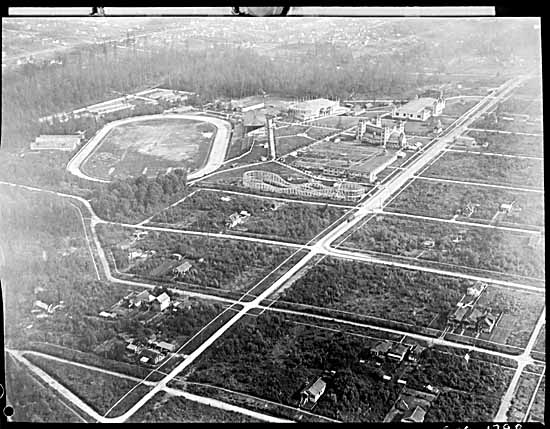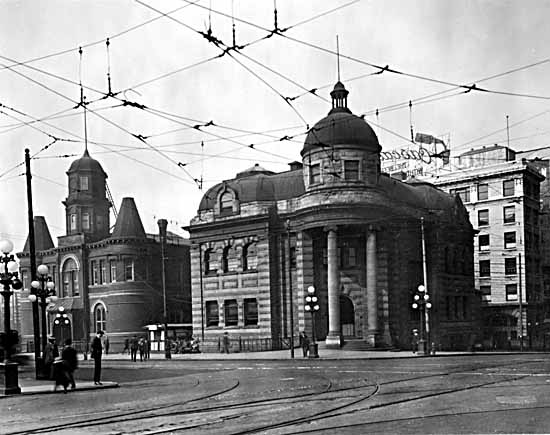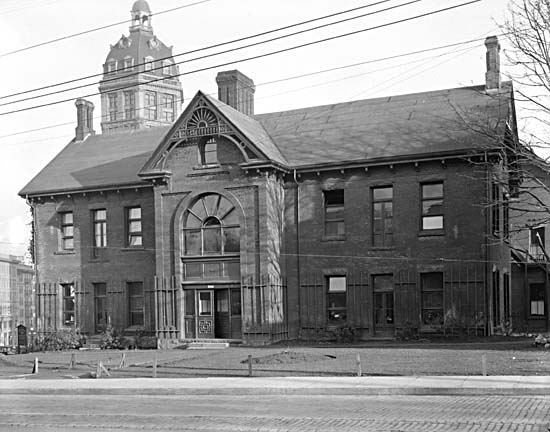
Aerial view of Hastings Park, ca. 1919. The park had been used as a barracks for soldiers during WWI, a relief camp in the 1920s, and an internment camp for Japanese during WWII. Photo: Stuart Thomson, Vancouver Public Library #1798
The winter of 1922 was called the “third winter of unemployment” in Vancouver. The city was plagued with chronically high unemployment in the years following WWI, especially in the winter months when the itinerant workers in BC’s forestry and mining sectors returned to the city in the off season. The City’s response was to set up a relief camp – a concentration camp for the unemployed – at Hastings Park.
In exchange for two days labour at various relief projects, unemployed men were given room and board at the camp, and could thus avoid starvation. Not surprisingly, they weren’t too happy about the arrangement, especially since many of them were Great War veterans who felt their wartime sacrifices warranted better treatment in peacetime. The government, on the other hand, viewed large numbers of angry unemployed men as a potential threat to the social order through much of the early 1920s.
The head of Vancouver’s Relief Department, George D. Ireland, sparked a protest after he reported to the Civic Harbor, Industries, and Employment Committee that there were a number of dope fiends and moral degenerates at the camp. If these deviants were kicked out of the camp, Ireland pointed out that they would “prove a menace to the community, [but] while stationed where they were their influence was dangerous to the younger men” in the camp. Ireland said he couldn’t back up his allegations with sufficient evidence to have them removed by the police.

The Carnegie Library and City Hall (left), the destination of several unemployed protest marches in early 1922. Photo circa 1920, VPL #10439
Mayor Tisdall and Chief Constable Anderson were concerned enough by Ireland’s claims that the police did investigate. Sure enough, Detectives Sinclair and Ricci found out that 28 year-old Ernest Hamilton was selling morphine at the camp. Detectives Ellice and Knox busted six other men at Granville and Robson, not for dope peddling, but for vagrancy. These six were also camp inmates, and had been delegated by a committee to solicit donations to help the 20 men who had been kicked out for insubordination and the 150 others who elected not to live in the camp. Police said the camp committee “had no right to authorize the men to beg.”
The men in the camp did not feel that a lone drug dealer out of 700 camp inmates justified Ireland’s smearing them all as dope peddlers and degenerates. Then on 25 January 1922, one of the camp leaders was kicked out for conducting a meeting in the recreation area, which was strictly against the camp’s militaristic rules. In response, 232 men marched from Hastings Park for what the papers called an “indignation meeting” at the headquarters of the Canadian National Union of Ex-Servicemen (CNUX) at 61 West Cordova Street (CNUX was likely an initiative of the Industrial Workers of the World, or IWW, which was listed in city directories as the occupant of 61 West Cordova).
The Sun reported that the “mob” was in “an ugly humor” and were threatening to riot, though they offered zero evidence to back up that claim. In fact, nothing in their report indicated that the procession and meeting were anything less than orderly. Just to be sure, Chief Constable Anderson pulled 15 constables off their beats and had them standby along with ten detectives at the police station. One of the marchers told a reporter that the source of their “ill humor” was Relief Officer Ireland’s allegation of degeneracy in the camp. “We may not be very high socially,” he said, “but the stigma of degenerate is going too far.”
The marchers were branded “deserters” for leaving Hastings Park. City Council took the position that they would support Ireland in however he decided to deal with the deserters if they chose to return to the camp. Some of them slept at the CNUX hall, and others found alternative accommodations. The next day they marched to City Hall, then located at Main and Pender streets. A delegation met with Mayor Tisdall and put forth their demands, which were that Ireland be fired; that they be paid in cash instead of in kind; and that they be permitted to stay downtown. The Mayor refused.
The next day, the unemployed again marched to City Hall, this time to ask for a permit to hold an open-air meeting at Hastings and Abbott. They marched with a red flag flanked by two Union Jacks, as required by a City by-law (and perhaps as a reminder of the flag many of them fought under during the war).
This time their numbers were augmented by unemployed from Burnaby, North Van, and South Van (still a separate municipality in 1922). It was a Saturday, and they learned that the Mayor was spending the weekend at his ranch. Alderman Pettipiece, the token labour rep on Council, told the protesters that only the Mayor could authorize an outdoor meeting. They decided to meet anyway, and marched off to the Cambie Street Grounds. The meeting and the marching were orderly, but arrangements were being made to have the RCMP brought in as back-up for a follow-up meeting expected the next day.
The next day, Chief Anderson and about 150 police were on hand to break up a meeting of about 600 unemployed men and their supporters at the Cambie Grounds. “The police were prepared to meet trouble,” according to the Sun, “but there was none.” In a speech to his men, Chief Anderson said it was time for a “showdown … Law and order must be upheld and if there is any trouble make it decisive.” Motorcycle cops were patrolling the vicinity and reserve constables were waiting at the police station in case things got out of control. Police surrounded the grandstand, including one column that “shut off escape from the south end of the stand.” Anderson interrupted the speaker to inform the crowd that a permit had been denied, and that he would give them a few minutes to disperse. “Without hesitation a motion was put that the meeting adjourn to be continued at the CNUX Hall, where a permit would not be necessary.”
But before they headed back to Cordova Street, one of the leaders called on Mayor Tisdall to address the crowd. To everyone’s surprise, the mayor had been sitting in the bleachers listening to the speakers. He got up and announced that he would not “address an illegal meeting,” though attending one didn’t seem to pose a problem. The unemployed and the police then marched back to their respective headquarters in military fashion.
Another parade of about six hundred unemployed marched to City Hall the following day in yet another attempt to press for Ireland’s dismissal and for relief workers to be paid in cash rather than in-kind and be allowed to live downtown to better enable them to take advantage of work opportunities. A delegation of nine was allowed in council chambers, while the rest mulled around Main and Hastings for a few hours trying to keep warm. A crowd of spectators also gathered. Apparently “much comment was aroused by the display of the red flag.”
One delegate told council that they refused to retreat one step … We will not go back to the park and we demand wages for our labor.” Another delegate said that they “object to being called lazy, lousy, moral degenerates and dope fiends.”
City Council gave Relief Officer Ireland discretionary powers in re-admitting any camp “deserters” who applied to return. At the request of Alderman Pettipiece, a special meeting of the Harbor, Industries, and Employment Committee was scheduled to review the situation of the unemployed.
Meanwhile, Chief Anderson continued to plan for mass violence. He kept the whole police force on call during the unemployed’s visit to City Hall. A flying squad waited at the police station and “other reserves [were] being rushed into action.” Police were pulled from their beats from around the city and the unemployed “malcontents” were kept under surveillance “so that any attempt on their part to hold unlawful assemblies or cause violence may be reported at once.”
But again, there wasn’t even a hint of violence, and upon being informed of Council’s decisions, the unemployed again marched off peacefully.
By 6 February 1922, almost all of the camp strikers returned to Hastings Park. The Sun reported that with their strike experiment now concluded, the men couldn’t been happier to be back in camp and that “the daily routine goes on with the smoothness of a happy family.” Mayor Tisdall claimed that the strike wasn’t the result of any bona fide grievances the men had, but rather that they had been “badly advised” by the men “chosen to represent the unemployed.”
More likely, the unemployed felt that although their immediate demands were refused, their activism helped keep the plight of the unemployed a political issue, not just in Vancouver, but across the province and the country. On 5 February, a meeting between Premier Oliver and representatives from Lower Mainland representatives resulted in Oliver promising to press Ottawa for funding for the public works projects that would ultimately alleviate unemployment in Vancouver. Federally, a parliamentary committee had been struck and was weighing recommendations from the Great War Veterans’ Association (GWVA) for the federal government to make investments in social housing and other projects that would attack the root causes of unemployment.
The 1922 relief camp strike foreshadowed many of the issues that would come up again in the much larger and more dramatic 1935 relief camp strike that culminated in the On-to-Ottawa Trek. The public and the unemployed were not convinced that militaristic relief camps were the best way to deal with unemployment crises, nor did they share the paranoia of government officials that demanded the unemployed be kept out of city centres. Like the unemployed in the depression, the 1922 men simply wanted to work for a wage. Their other demand – that George Ireland be dismissed as head of the relief department – would be realized in the 1930s, after he was caught lining his pockets with relief funds and thrown in jail.



No comments:
Post a Comment